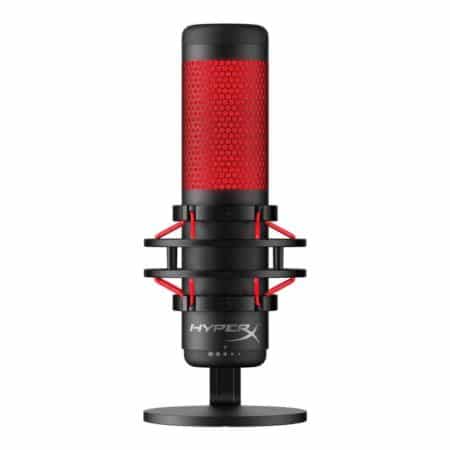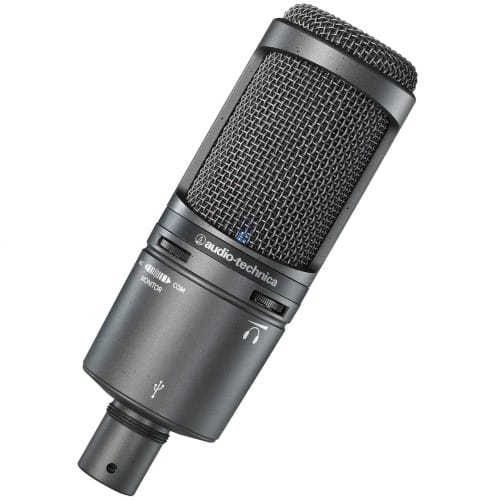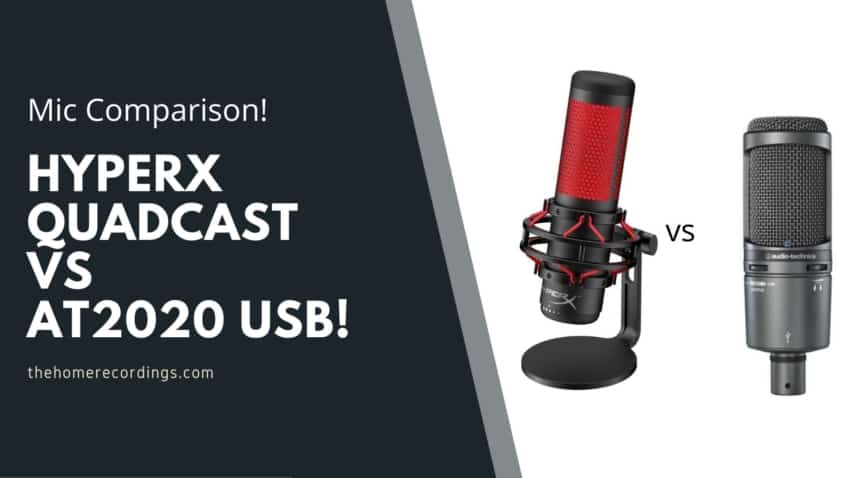Last updated on December 29th, 2023 at 09:57 pm
The Audio-Technica AT2020 USB is one of the best-known USB microphones out there, only rivaled in popularity by the famous Blue Yeti.
HyperX came out with the Quadcast, which is a microphone that is almost identical to the Blue Yeti in every way, but very different from the AT2020 USB.
In this article, I will go over the differences between them, their overall features, and which one I believe you should get, and I have to say that the answer is very one-sided.
So, without any further ado, let’s get started!
Differences
The HyperX Quadcast offers Cardioid, Omni & Bidirectional, as well as Stereo polar patterns, making it a very versatile microphone.
The Audio-Technica only features a cardioid polar pattern, but the audio quality and build quality are much better, making it the best overall choice since you will only be using a cardioid pattern most of the time.
Let’s get into the specifics of each microphone, their features, and more!
HyperX Quadcast

So, firstly this microphone is clearly aimed towards gamers who want to stream their gameplay, or just YouTubers in general, because of the way it looks.
Of course, it can be used to do almost anything since it’s a very versatile microphone, but even though I like its appearance, it’s definitely not as professional-looking as some other microphones, including the AT2020 USB
The HyperX Quadcast comes with the following pickup patterns: Cardioid-, Omni-, Bi-directional-, and stereo patterns.
It comes attached to a desk-stand that also has a built-in shock mount, and this is definitely a really nice bonus to have since it will either completely avoid picking up unwanted vibrations coming from the desk, or at least reduce them significantly.
Note: The AT2020 USB doesn’t come with a built-in shock mount.
On the back of the microphone you’ll have access to the USB connection and to a headphone jack that lets you do zero-latency monitoring.
Once the microphone is connected and working, it will light up in a really nice red color (I used to think that this was the color of the microphone itself, but it’s actually thanks to the internal lighting).
On the top of the microphone you’ll find a touch-sensitive “Mute” button; When the mic is muted, the background light inside the microphone will turn off.
This is a really nice feature to have for two reasons; Most USB microphones don’t have this option and you need to turn the Gain dial all the way down if you want to mute it, and getting the exact same level afterwards can be tricky.
This way you only need to unmute it and you’re back recording at the exact same level.
The other reason is that since the microphone only lights up when it is recording, you’ll have visual feedback when it’s muted or not.
Now, I mentioned that it comes with four different pickup patterns, and while they all may have their place, you’re probably going to be using the cardioid one the most, especially if you’re doing voice-over, singing, Streaming, etc. since it’s designed to only pick up what is right in front of the mic.
The Omni polar pattern is designed to record everything surrounding it, and if you want to do a podcast and only have this microphone, then this would be the polar pattern of choice.
Lastly, the Stereo and Bi-directional patterns are identical, with the only difference being that the bi-directional picks up sound from the front and back, while Stereo picks up sound from both sides.
If you’re interviewing someone, then Bi-directional is the best one, while if you want to record and acoustic guitar for example, stereo would be best.
How does it perform?
For spoken word, voice over, streaming, etc. I found it to be a good microphone; it sounds full and I needed to do little-to-no editing after the recording was done in order to get a professional sound out of it.
For music, on the other hand, I don’t recommend it.
I recorded my acoustic guitar with it and the Stereo Pattern did work quite well, even though it lacked a bit in the lower end.
With the Cardioid pattern however, it sounded way too boomy for my taste, which is kind of the opposite of what happened with the stereo pattern.
Another issue I found was with the pop filter, which is designed to reduce unwanted plosives when you’re talking;
It is definitely far from the best and if you’re going to be speaking straight into the microphone, then I’d highly recommend purchasing an external pop filter, otherwise get ready to re-record everything multiple times.
One other issue popped up when I mounted it on a regular mic-stand using the adapter; there’s little to no room between the mic and the mic-stand and this creates unnecessary pressure on both the USB- and headphone cables…
So, imagine how long those cables will last? Not to mention the USB and headphone connectors themselves.
Now, one huge pro of this microphone is the “Mute” button on the top, which is something I wish more USB microphones would feature, and also that it comes with a shock mount, so yes, there are some really good things that HyperX did right here.
Lastly, this microphone is marketed towards gamers mostly, so why on earth does it need four polar patterns? You only need a Cardioid one as a gamer/streamer and the cost could’ve been significantly lower if they didn’t include the extra three.
This is definitely a con, but some people may use those extra patterns sometime.
What comes in the Box?
- The HyperX Quadcast Microphone
- USB Cable
- Mic Stand adapter
Features
- Tri-capsule array: three condenser capsules inside
- Multiple pattern selection: cardioid, stereo, omnidirectional and bidirectional
- Gain control, mute button, zero-latency headphone output
- Good for podcasting, voiceovers, game streaming, interviews and conference calls
- Plug ‘n play: Mac and PC compatible
- Desk stand included (already attached to the mic)
- Mic-Stand adapter (may hurt the cables)
Specifications
- Polar Pattern; Cardioid, stereo, omni- and bidirectional
- Frequency Response: 20Hz- 20kHz
- Sample Rate: 48kHz/16-bit
- Sensitivity: -36dB
- Weight: 254g
Find out more about the HyperX Quadcast here.
Audio-Technica AT2020+ USB

There are few better-known brands in the music industry than Audio-Technica.
They make some of the best microphones available on the market and the AT2020 is the go-to mic for almost every beginner home recording enthusiast, plus you won’t see a studio that doesn’t have at least a couple of them.
The USB version of the Audio-Technica AT2020 is just as good as the XLR AT2020 with the advantage of being a plug n’ play microphone that works both on Windows and Mac OS without the need of installing any sort of driver.
It comes with a built-in headphone jack and a volume control that allows you to directly monitor what is being recorded with no delay (Zero latency).
It also offers a mix control that blends the microphone and the pre-recorded audio.
The controls on the AT2020 aren’t as easy to use as I would have liked, and this is something that is definitely easier to do on the HyperX Quadcast.
One thing I like about the AT2020 is that it’s small and lightweight, which makes it an excellent microphone for travelling and recording on the go.
Just like all the Audio-Technica microphones, the AT2020+ is extremely well built.
When holding it in my hand it doesn’t feel like a cheap product at all, quite the opposite actually.
Lastly, the AT2020+ can be used for anything voice related, recording music, YouTube videos, etc.
How does it Perform?
Since the AT2020 is a plug n’ play microphone, you should have absolutely no issues getting it to work; simply connect it and that’s it, you can now record!
The sound quality is excellent, and I mean excellent, especially considering the price, since you probably won’t find another USB microphone at this price range that sounds this good.
The only thing I don’t like that much is that it can sound a bit crispy at times, but that isn’t that much of an issue really since you can fix that with just a bit of EQ afterwards.
I often refer to the AT2020+ as my top recommendation for anyone who is looking for a cardioid condenser USB microphone simply because of the overall sound quality.
It records vocals extremely well, and I believe that recording voice-related audio is where this microphone really shines.
Of course, it can be used for recording acoustic and classical guitars as well, which is what I used it for before getting some of the other microphones I own.
One big con though is that when recording an overdriven electric guitar it may take you a while to fine-tune the tone, find the correct mic position, etc.
And this is an issue that I had, since it took me over 10 min to get a decent tone out of it, and I still didn’t quite like it.
Everything else, sounded fantastic!
There’s a reason why the AT2020 (XLR Version) is part of almost every music studio, and that is because when taking cost-effectiveness into account, there are few microphones that can stand up to it.
The USB version is just as good, just a bit more expensive… But it doesn’t require you to purchase a separate audio interface!
Related: Here’s a post where I compare the Blue Yeti to the AT2020+, should you be interested.
What do you get in the Box?
- The Audio-Technica AT2020+ USB microphone
- Tripod desk stand
- USB cable
- Storage Pouch
Features
- Headphone Output with volume control
- Tripod desk stand and USB cable included
- Mac and PC Compatible
- Built-in headphone jack
- Mix and Volume Control
Specifications
- Polar Pattern: Cardioid
- Frequency Response: 20Hz- 20kHz
- Sample Rate: 44.1kHz – 48kHz/16-bit
- Weight: 386g
Find out more about the AT2020 USB here: Amazon, Sweetwater, Guitar Center.
Which one should you choose?
The Audio-Technica AT2020 USB, hands down! The reason for this is that it sound better, even though it doesn’t feature a gain knob and it doesn’t come with all those additional polar patterns.
Having extra polar patterns can be nice, but it’s definitely not necessary considering that you will most likely be using the cardioid one 99% of the time.
So, go with the AT2020 USB.
Conclusion
I prefer microphones that are designed to do one thing and one thing only, since they are usually better at it than those “jack of all trades but master of none” type of mics, and the HyperX Quadcast is definitely a jack of all trades.
If you need to record a podcast, have guests over, etc. and you know that you will be able to take advantage of the additional polar patterns, then go with the HyperX Quadcast, or even better, the Blue Yeti, otherwise stick to the AT2020.
I hope this information was useful!
Have a wonderful day!
